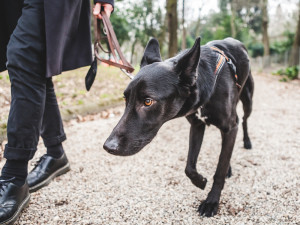Some Dogs Are Scaredy Cats — And That’s OK
Not all fearful dogs have been mistreated.
“She must have been abused,” is a comment I hear with alarming regularity. When a dog cowers and shakes or barks and growls at a person wearing a hat, it’s natural to think that the strong reaction is proof of previous harsh treatment by someone wearing a hat. It’s easy to conclude that a dog who’s scared of children was teased by the neighborhood bully. Similarly, it’s logical to assume that a dog would only react aversely to a broom after having had terrifying experiences with one.
Without a doubt, far too many dogs suffer abuse, but not all dogs who appear to have been abused have necessarily been treated badly. Some are fearful because they were inadequately socialized, or have a genetic tendency to be fearful, or both. As often as not, a history of abuse is actually not a factor.
Get (totally free) deals for food, treats, accessories, tech and way more pet parenting must-haves.
Why Some Dogs Are Afraid of Men
The most common scenario that leads people to conclude that a dog has been abused is the dog who’s fine with women but scared of men. In these cases, while it’s possible that a man abused the dog, the fact that a dog is afraid of men doesn’t prove the theory. Typically, dogs who have fearful tendencies are more scared of men than of women. I’ve met hundreds of dogs who were only scared of men, and exactly two who feared women more. The fact is, dogs who are fearful have a natural propensity to be more afraid of men. Nobody knows for sure why this is, but it’s likely that men’s larger size, broader shoulders, deeper voices and facial hair make them more intimidating.
Another reason that dogs might be more afraid of men was suggested by a study reported in Current Biology: When motion was detected only on point light displays*, observers perceived an interesting difference between male and female movement. Figures considered masculine in gait seemed to be approaching, while both feminine and gender-neutral gaits were seen as heading away. Fearful dogs are typically most frightened when something scary moves toward them — this may explain why they find men more alarming than women.
How Scent Plays into Fear
Scent may also be a factor: “Olfactory exposure to males, including men, causes stress and related analgesia in rodents,” according to a report in Nature Methods. The study showed that mice and rats react differently to male and female experimenters because of differences in the way that they smell. That means that all studies of these rodents’ behavior may have been influenced by the gender of the people conducting the study. The test animals became highly stressed and exhibited decreased pain responses in the presence of human males; even T-shirts worn by men (but not those worn by women) caused this reaction.
The rodents were similarly stressed by odors from males of a range of species, including dogs, cats, guinea pigs and even other rodents. Males release certain pheromones in larger concentrations than females — and these fear-inducing chemicals are shared among mammals — which means that dogs could also be affected by them. Scent differences could very likely affect dogs and cause them to be more frightened around some people.
Misunderstandings About Fearful Dogs
The assumption that fear of men indicates a history of abuse by a man is not the only one that may be erroneous. Many people are sure that dogs who react negatively to people with hats or backpacks means there has been past abuse by a person sporting those same accessories. While again, this is possible, it’s more likely that the dog is simply unfamiliar with the objects themselves and the way that they change people’s appearance. Many react fearfully to a changed silhouette, becoming frightened, for example, by the sight of someone they know and love wearing a hat. Once the person removes the hat, the dog switches to happy greeting behavior.
Another commonly misunderstood area relates to the fear of children. Many dogs are skittish around children because of their erratic behavior, especially if they were not well socialized to them at an early age. After all, from a dog’s perspective, kids behave in peculiar and unexpected ways. They change direction suddenly, roll on the ground, move at variable speeds, make weird noises and are generally high-energy hurricanes. Dogs who are naturally fearful may find excitable, loud humans in motion to be unpredictable, which is frightening. (On the flip side, there are fearful dogs who do fine with kids, but are terrified of adults. Usually, such dogs have had positive experiences with children and are used to their erratic behavior.)
How to Tell if a Fearful Dog Has Been Abused
If a dog’s fearfulness toward specific types of people or certain everyday items doesn’t necessarily mean that the dog has been abused, how can you tell if your dog suffered from abuse in the past? The honest answer is that — unless you have the dog’s full backstory — you can never know for certain. However, some clues may help you make an educated guess. Abuse is less likely as an explanation for a dog’s fearfulness if the dog’s reactions fit the pattern associated with dogs who are naturally fearful.
The most common pattern is for such dogs to be cautious around strangers, especially men, and to be worse around tall, deep-voiced men with beards, or anyone carrying things — garden tools, brooms or mops, a clipboard — or wearing sunglasses, a backpack, or a hat. Dogs with a generally fearful approach to the world often react most vigorously when unfamiliar people approach, look directly at them, stand up from a sitting position or reach down to pet them.
If the dog has sustained multiple injuries, such as broken bones or teeth, or has scars on its face and body, abuse is more likely. Of course, those injuries could be a result of accidents, and some forms of abuse leave no scars. Still, a dog with unexplained evidence of physical trauma is more likely to have been a victim of abuse than a dog without it.
If a dog is fearful of highly specific attributes, it is more likely to be based on trauma, which could have come in the form of abuse. So, if a dog is afraid of freckled, redheaded children with glasses in the age range of 10 to 12 years, but fine with all other kids, it’s more likely that a negative experience with a child of that description caused the fear. On the other hand, if a dog is only okay with children who are older than about 16, my bet would be that the dog lacks experience with a wide range of children and is only comfortable with children who are more adult-like in size and behavior. Similarly, if the dog is okay with men unless they are wearing loafers with a buckle, I would be inclined to suspect abuse. Specificity of fears is more likely to indicate abuse, because dogs who are generally fearful are usually set off by a wider range of triggers.
Other Exceptions to Keep In Mind
Even in the case of a specific fear, we have to be careful about assuming that abuse was the cause. For example, I had a client whose dog was fearful of and aggressive toward only one person. Sounds like that person might have beaten the dog, right? Not in this case. The man the dog was afraid of was the neighbor who had saved the dog’s life during a house fire; the wonderful man went into the house and carried the dog out before the firefighters arrived. Until then, the dog liked this man, but was terrified of him after the fire, presumably because he associated the man with the horrible experience.
While anyone who loves dogs wants to know if a particular dog has been abused, the same process is used to help a dog overcome fears of any origin. Classical conditioning, desensitization and patience will serve people and dogs equally well. It’s critical not to force a frightened dog into situations that provoke fear, but instead, to protect the dog from scary circumstances. Be gentle and kind and refrain from using punishment. Feel free to comfort any dog who is scared without worrying about the common (but misplaced) warning that this will reinforce the fear. Accept that many fearful dogs never become gregarious, go-with-the-flow types, and love them for who they are rather than who you think they should be.
Some people seem relieved when I tell them that their dog may not have been abused, while others seem disappointed to give up the “feel good” story of adopting a dog who was mistreated. I empathize with both groups: I can understand the relief, and I can also understand how gratifying it feels to give a loving home to a dog who only knew cruelty before. And while I certainly can’t say definitively which dogs with unknown histories have been abused and which haven’t, I agree with other progressive trainers and behaviorists that abused dogs are not as common as one might think.
* Point-light displays are made by filming people, animals or objects with reflective markers or point lights attached to the major joints, and then processing the video so that only the point lights are visible.





